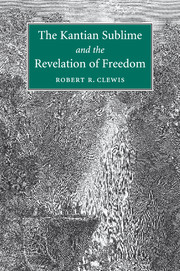Book contents
- Frontmatter
- Contents
- Preface and acknowledgments
- Abbreviations and notes on Kant's texts
- Introduction
- 1 The Observations and the Remarks
- 2 The judgment of the sublime
- 3 Moral feeling and the sublime
- 4 Various senses of interest and disinterestedness
- 5 Aesthetic enthusiasm
- 6 Enthusiasm for the idea of a republic
- 7 Conclusion
- Appendix 1 On the Remarks
- Appendix 2 Some features of the feelings discussed in this book
- Appendix 3 Classification of what elicits sublimity
- Bibliography
- Index
4 - Various senses of interest and disinterestedness
Published online by Cambridge University Press: 02 July 2009
- Frontmatter
- Contents
- Preface and acknowledgments
- Abbreviations and notes on Kant's texts
- Introduction
- 1 The Observations and the Remarks
- 2 The judgment of the sublime
- 3 Moral feeling and the sublime
- 4 Various senses of interest and disinterestedness
- 5 Aesthetic enthusiasm
- 6 Enthusiasm for the idea of a republic
- 7 Conclusion
- Appendix 1 On the Remarks
- Appendix 2 Some features of the feelings discussed in this book
- Appendix 3 Classification of what elicits sublimity
- Bibliography
- Index
Summary
How can a pure aesthetic judgment, which according to Kant is disinterested, contribute to the interests of reason (Vernunftinteresse)? It is essential to understand the various senses of interest and disinterestedness that Kant uses in order to comprehend reason's interest in the sublime as a disinterested aesthetic judgment and as a revelation of freedom. Accordingly, this chapter elucidates various senses of interest and introduces several fundamental distinctions to see how reason can take an interest in the sublime.s
INTEREST
There are many ways of understanding Kant's claim that a judgment is disinterested. Indeed, part of the reason Kant's notion of disinterestedness has been criticized so widely in contemporary ethics and aesthetics is that he uses the concept in so many distinct ways. Since we can evaluate Kant's position better if we properly understand what he is actually saying, I would like to distinguish the various senses of disinterestedness and interest.
Disinterestedness, as a counterpart to interest, clearly depends on how interest is understood. Kant uses “interest” pervasively throughout his writings, though often in different ways (e.g., KrVa466/b494; a655/b683; a805/b833).
- Type
- Chapter
- Information
- The Kantian Sublime and the Revelation of Freedom , pp. 146 - 168Publisher: Cambridge University PressPrint publication year: 2009



